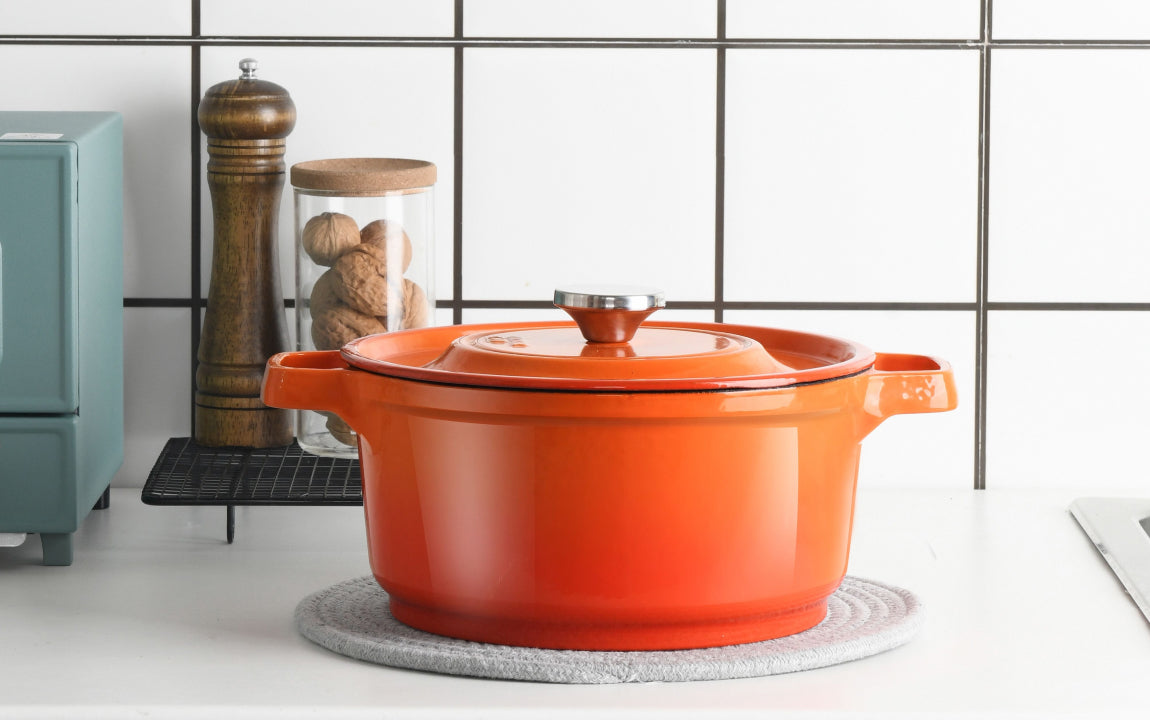Is My Cookware Safe?

Is My Cookware Safe?
If most of your interests and hobbies lie outside the kitchen (like me), it’s likely that you may not give a lot of thought to your cookware. “Getting the job done” doesn’t always mean getting it done safely! Here are some reasons to inspect your cookware:
- Along with the air we breathe and water we drink, the food we eat is enormously important to our health, and what we use to prepare it is important. Unsafe cookware can leach chemicals into the food.
- Cooking on a stove or oven raises temperatures above the limits of safety for many cookware materials, giving off harmful gases (VOCs) into the air, which can be breathed in by everyone in the area.
Let's start with types of universally safe cookware:
- Cast iron: It’s a tried and true material that is the original “non-stick” surface! When cared for properly, cast iron pans can last decades. It even has the benefit of transferring minimal amounts of iron to your food (only a problem if you are high in iron already). Here is how to season and maintain your cast iron cookware (it really is easier to maintain a cast-iron pan than anything else--mine stays on the stove and is used almost every day!)
- Stainless steel: My dad always said when we kids were pestering him, “You can’t hurt steel!” Stainless steel gives back in durability, for sure. It’s a great pot for boiling and simmering, and if you use appropriate amounts of oil or butter for frying, you can even cook delicate eggs without sticking.
- Glass: Mainly used for baking, glass is a great inert vessel, although not as durable as cast iron or stainless steel.
Now for the questionably safe cookware materials:
- Teflon and other non-stick coatings: Teflon is the trade name of a non-stick coating that contained PTFE (Polytetrafluoroethylene). PTFE was made with PFOA up until 2015, when PFOA was discovered to be toxic to pet birds (and to humans). This happens when the coating is overheated (easy to do) or scratched (also easy to do!), emitting PFCs (perfluorinated compounds) that can cause certain cancers and affect the thyroid and the immune system. However, PTFE continues to be manufactured using chemicals similar to PFOA, which still emit PFCs. If you are still in love with your non-stick omelet pan, I would make sure never to place it empty on a heated burner or flame (to avoid overheating), be sure to run the stovetop vent the whole time, until the pan is cooled, and of course, use utensils and cleaners that won’t scratch the coating.
- Coated ceramic pans: The technology behind getting a ceramic coating on a metal pan is nanotechnology, which uses super-small particles. This study from 2017 showed that a significant amount of titanium nanoparticles can be released when cooking slightly acidic food or accidentally scratching the pan. Green is a color and name that has been used for decades to denote safe, people and earth-friendly materials, right? It just really messes with our brains, then, when a product that uses green doesn’t live up to the name. Many ceramic coated pans with nanoparticle coatings use the green color, and “GreenPans” is a manufacturer that uses 3 known toxic compounds in their pans. You may think twice about the “green” claims of these type of pans!
- Silicone: What!? After Martha Stewart spent the 1990’s using SilPat baking mats, I thought that the safety of silicone cookware was unquestioned. It comes in a ton of fun colors and is non-stick, a biggie in my book. Although the FDA says that food-grade silicone does not cause harmful chemical contamination (is safe) up to 428 degrees Fahrenheit (220 C), some recent studies show that silicone bakeware loses weight at these high temperatures. Where does the weight go? Into our food or the air we breathe. “When used at temperatures above 200 deg F silicone cookware releases volatile organic compounds (VOCs) into your air and siloxanes into your food.” (Mary Caldarelli, Is Silicone Cookware Safe?) This author does a great job of explaining how silicone cookware is made (with additives) and what is potentially harmful in it. She is educated in environmental health and runs a very informative website. So for now, you may consider using silicone at lower temperatures like food storage.
- Plastic: Plastic cooking utensils may be tempting to bring to the potluck just in case they don't find their way back home. But add heat to them for cooking or washing, and dangerous chemicals can find their way into your food, fast. Among them are brominated flame retardants, which have been linked to births of low weight and size. Water and soda bottles are also tempting to reuse (save the planet, right?) but washing in warm water can cause these to release BPA and phthalates, which are linked to cancer, infertility, cognitive and developmental problems and obesity, among other conditions. Styrofoam take-out containers and opaque cutlery contain polystyrene, which is a possible carcinogen. There are many more plastics out there that have similar effects. What's the takeaway here? Plastics just don't play well with our foods! Even though some frozen quick meals and veggies are designed to be baked or microwaved in their plastic or coated cardboard containers, you can usually take the safer route by transferring the contents to a glass container with loose-fitting lid for the microwave, or oven-safe baking container with foil. Add a splash of water to veggies and voila! You have safer fast food (frozen lasagna is a bit hard to transfer, I'll admit)!






